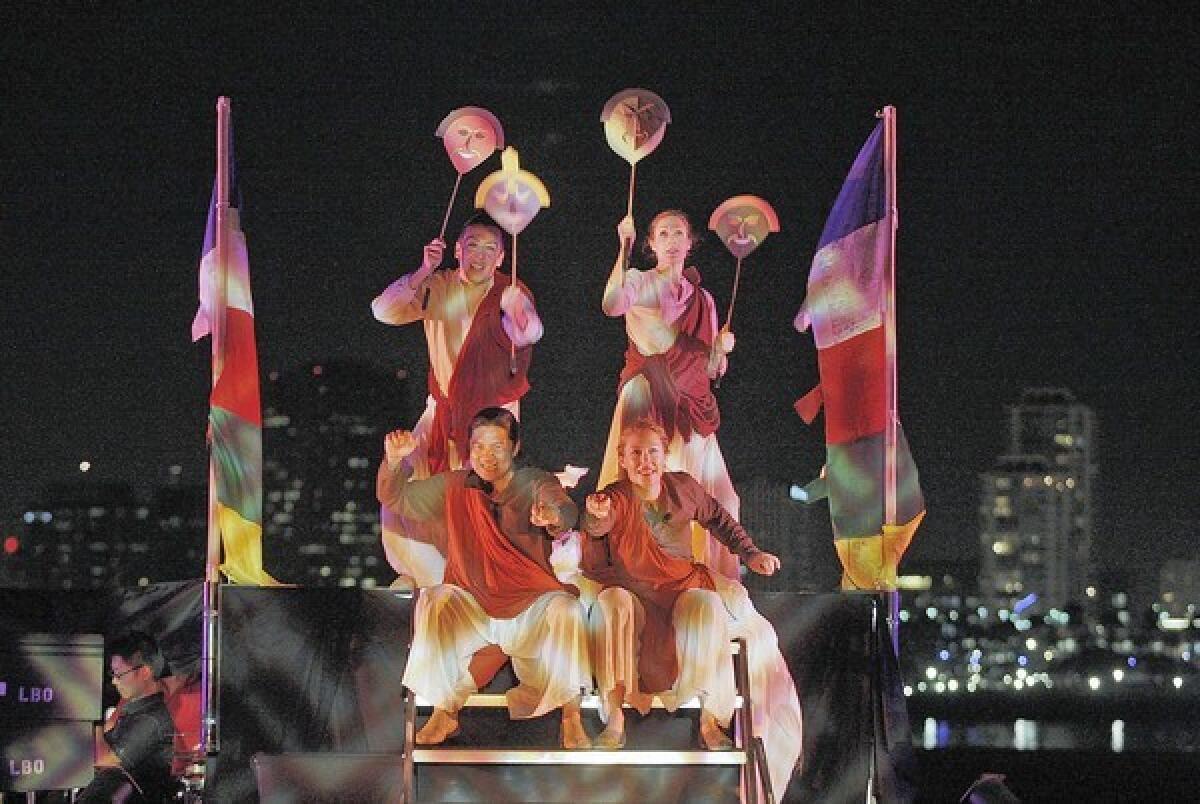Review: Long Beach Opera’s ‘King Gesar’ channels a legend

In the world of postmodern opera production, setting “Carmen” on a cruise ship or “La Bohème” on a submarine is no longer considered eccentric. Stage directors are paid to come up with concepts. And so for his Long Beach Opera production of Peter Lieberson’s “King Gesar” on Saturday night, Andreas Mitisek had both the Queen Mary and a submarine docked in front of it. His backdrop was the Long Beach skyline. He even included the sounds of Long Beach’s beloved Lobster Festival wafting over the bay.
What was unusual, though, was that this was no concept. It just happened to be, for a variety of reasons, where we were — seated on folding chairs facing a makeshift outdoor stage in Long Beach’s Harry Bridges Memorial Park. The park is adjacent to where the Queen Mary and the submarine are docked.
Still, the vessels have nothing to do with “King Gesar,” which is based on a Tibetan Buddhist legend. Nor, for that matter, is “King Gesar” an opera. The production is part of what LBO calls, rightly so, its Outer Limits series, which began last September with Gavin Bryars’ “The Paper Nautilus” performed in an aquarium.
PHOTOS: Arts and culture in pictures by The Times
“Gesar” is a chamber score for narrator and small instrumental ensemble that Lieberson said he hoped would evoke traditional Tibetan campfire storytelling under a starry sky, where food, music and, perhaps, mind-altering substances enhance the experience.
LBO’s idea was to make this experience (well, not necessarily the drugs) real by performing the 50-minute work on the beach in front of a campfire. But we now have yet another case in the long history of opera versus the authorities. Campfires are but one of many operatic activities not allowed on the Long Beach sand. A grassy knoll and a fake fire had to do, with such urban intrusions as nostalgic rock ‘n’ roll wafting over the bay and a police helicopter circling overhead part of the ambient mix.
The biggest challenge of all, though, may have been the intriguing notion of dramatizing what “Gesar” was meant to conjure. Lieberson wrote the 1991 score for a classy instrumental octet that included cellist Yo-Yo Ma and pianists Peter Serkin and Emanuel Ax and was commissioned by Hans Werner Henze for his Munich Biennale of new music theater. Music and a single narrator, who assumed all the roles, accomplished the theatrical conjuring.
Mitisek, who is LBO’s artistic and general director, divided the narration between Danielle Marcelle Bond and Roberto Perlas Gomez and added dancers Javier Gonzalez and Kelly Ray. The stage was a small, two-tiered platform with the dancers atop — their job was to convey a sense of ritual or, behind a sheet, provide a shadow play for a battle scene.
The story is the life of Gesar, who grew up the son of a servant of the king of Ling but who was dubbed by the gods to be the next king. That required winning a horse race with cunning and magic. Gesar proved a good king. His spiritual convictions could not be shaken, but he was also a great warrior, able, again with supernatural assistance, to soundly defeat his enemies.
CRITICS’ PICKS: What to watch, where to go, what to eat
Often inspired by Buddhist myths, Lieberson brought to his flickering score a sense of raucous color and glorious theatrical effects. The cello solos are rhapsodic, the pianos glisten like stars in the sky, the flute is used seductively, brass and percussion call forth spectacle. The spellbinding narration of Douglas Penick’s poetically vivid text ranges from shamanistic declamation to rhythmic patter to song.
Turning all this into actual theater inevitably means a loss of some of that spell. But Mitisek’s modest staging and the two effective narrators demonstrated that there really is theater implied in every second of “Gesar.”
The instrumental component, however, suffered. Kristof Van Grysperre, LBO’s new associate conductor, led a concise performance with excellent players. But outdoor amplification couldn’t convey the sheer beauty of Lieberson’s writing. The piano parts were relegated to electronic keyboards, and much sonic splendor was lost in the translation.
The good news about the amplification was that it mostly drowned out background noise, including the lobster goings-on. And the good news about this “King Gesar” was that, in true Buddhist fashion, its function wasn’t to transcend the everyday world but to fit in with it. Even in the shadow of the Queen Mary.
The production repeats Friday and Saturday night, and it also serves as a prelude for the Los Angeles Philharmonic premiere next month of Lieberson’s “Shing Kham.” The work, a percussion concerto, was left unfinished by the composer, who died two years ago, but has been completed by Oliver Knussen, who coincidentally was the catalyst for the “King Gesar” commission.
More to Read
The biggest entertainment stories
Get our big stories about Hollywood, film, television, music, arts, culture and more right in your inbox as soon as they publish.
You may occasionally receive promotional content from the Los Angeles Times.







